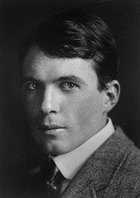William Lawrence Bragg
|
|
William Lawrence Bragg (March 31, 1890 - July 1, 1971) was a physicist who won the Nobel Prize in Physics in 1915.
Bragg was born in Adelaide, South Australia. He was an impressionable boy and showed an early interest in science. His father, William Henry Bragg, was Professor of Mathematics and Physics at the University of Adelaide. Shortly after starting school aged 5, William Lawrence Bragg fell from his tricycle and broke his arm. His father had recently read about Röntgen's experiments in Europe and used the newly discovered X-rays to examine the broken arm. This is the first recorded surgical use of X-rays in Australia.
Bragg was a very able student. In 1904, aged 15, he went to the University of Adelaide to study mathematics, chemistry and physics. He graduated in 1908, aged 18. In the same year his father accepted a job at Leeds University, and brought the family back to England. He entered Trinity College, Cambridge in the autumn of 1909. He received a major scholarship in mathematics, despite taking the exam while in bed with pneumonia. After initially excelling in mathematics, he transferred to the physics course in the later years of his studies, and graduated in 1911.
William Lawrence Bragg is most famous for his law on the diffraction of X-rays by crystals. Bragg's law makes it possible to calculate the positions of the atoms within a crystal from the way in which an X-ray beam is diffracted by the crystal lattice. He made this discovery in 1912, during his first year as a research student in Cambridge. He discussed his ideas with his father, who developed the X-ray spectrometer in Leeds. This tool allowed many different types of crystals to be analysed. The collaboration between father and son led many people to believe that the father had initiated the research, a fact that upset the son.
William Lawrence Bragg's research work was interrupted by both World War I and World War II. During both wars he worked on sound ranging methods for locating enemy guns. In autumn 1915, his brother Robert was killed. At about the same time William Lawrence Bragg received the news that he had become the youngest person ever to receive the Nobel Prize in Physics, aged 25. Between the wars, from 1919 to 1937, he worked at the Victoria University of Manchester as Langworthy Professor of Physics. He married in 1921, to Alice Hopkinson. He was knighted in 1941. After World War II, he returned to Cambridge, splitting the Cavendish Laboratory into research groups. He believed that 'the ideal research unit is one of six to twelve scientists and a few assistants'. In 1948 William Lawrence Bragg became interested in the structure of proteins. Although he played no direct part in the 1953 discovery of the structure of DNA, James D. Watson admits that the X-ray method that Bragg developed forty years before was at the heart of this profound insight into the nature of life itself.
In April 1953 William Lawrence Bragg accepted the job of Resident Professor at the Royal Institution in London. He proposed that the Royal Institution should perform some form of public service, and suggested series of lectures to show experiments to schoolchildren. This idea was met with an enthusiastic response, and by 1965 20,000 schoolchildren were attending these lectures each year. He worked at the Royal Institution until his retirement in September 1966.
William Lawrence Bragg's hobbies included painting, literature and a life-long interest in gardening. He received both the Copley Medal and the Royal Medal of the Royal Society, and in 1967 was made a Companion of Honour by the Queen. He died at a hospital near his home at Waldringford on 1st July 1971.
External link
- William Lawrence Bragg (http://www.nobel-winners.com/Physics/william_lawrence_bragg.html)de:William Lawrence Bragg
es:William Lawrence Bragg ja:ローレンス・ブラッグ nl:William Lawrence Bragg sk:William Lawrence Bragg

